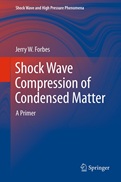Shock Wave Compression of Condensed Matter
A Primer
Jerry W. Forbes
ISBN 978-3-642-32534-2
ISBN 978-3-642-32535-9 (eBook)
DOI 10.1007/978-3-642-32535-9
Springer Heidelberg New York Dordrecht London
|
This book is published by Springer as part of their Shock Wave and High Pressure Phenomena book Series. It is available as a hardcover or/and an ebook. The ebook version contains a video of a shock wave propagating in an impacted aluminum plate and two detonation waves colliding. These videos are from a proton radiographs published by Los Alamos National Laboratory who gave permission to use them in this book. |
|
|---|
Summary
This graduate level book introduces the core concepts of the shock wave physics of condensed matter, taking a continuum mechanics approach to examine liquids and isotropic solids. The text primarily focuses on one-dimensional uniaxial compression in order to show the key features of condensed matter’s response to shock wave loading. The first four chapters are specifically designed to quickly familiarize physical scientists and engineers with how shock waves interact with other shock waves or material boundaries, as well as to allow readers to better understand shock wave literature, use basic data analysis techniques, and design simple 1-D shock wave experiments. This is achieved by first presenting the steady one-dimensional strain conservation laws using shock wave impedance matching, which insures conservation of mass, momentum and energy. Here, the initial emphasis is on the meaning of shock wave and mass velocities in a laboratory coordinate system. An overview of basic experimental techniques for measuring pressure, shock velocity, mass velocity, compression and internal energy of steady 1-D shock waves is then presented. In the second part of the book, more advanced topics are progressively introduced: thermodynamic surfaces are used to describe equilibrium flow behavior, first-order Maxwell solid models are used to describe time-dependent flow behavior, descriptions of detonation shock waves in ideal and non-ideal explosives are provided, and lastly, a select group of current issues in shock wave physics are discussed in the final chapter.
Keywords
Hugoniots and shock thermodynamics - compressed condensed matter - impedance matching for shock waves - phase transformation under shock loading - plane shock waves - rarefaction waves - shock wave physics textbook - shockwave physics graduate text - stress gauges for shock wave measurements
Table of Contents
Introduction of Shock Wave Physics of Condensed Matter.- Plane One-Dimensional Shock Waves.- Impedance Matching Technique.- Experimental Techniques.- Thermodynamics of Shock Waves.- Solids.- Differential Conservation Equations and Time-dependent Flow.- First-order Polymorphic and Melting Phase Transitions Under Shock Loading.- Secondary Ideal High Explosives, Non-steady Initiation Process, and Steady Detonation Wave Models.- Steady Detonation Waves in Right Circular Cylinders of Non-ideal Explosives.- Special Topics: Lagrangian Coordinates, Spall, and Radiation Induced Shocks.- Appendices.


